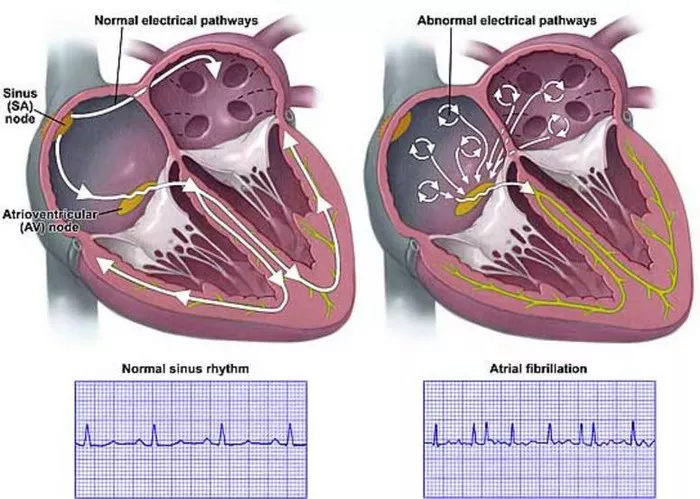Atrial fibrillation (AF) and ventricular fibrillation (VF) are two types of abnormal heart rhythms, known as arrhythmias, that can have serious implications for heart health and overall well-being. While both conditions involve irregular electrical activity in the heart, they differ significantly in terms of severity, causes, symptoms, diagnosis, and treatment. This article aims to provide a comprehensive comparison of atrial fibrillation and ventricular fibrillation to help readers understand the differences and the implications for clinical management.
Causes of Atrial Fibrillation and Ventricular Fibrillation
Atrial Fibrillation (AF):
AF is often associated with underlying heart conditions, such as hypertension, coronary artery disease, heart valve disorders, and congenital heart defects. Other risk factors include obesity, diabetes, sleep apnea, excessive alcohol consumption, and thyroid disorders. Age also plays a role, with AF becoming more common as individuals get older.
Ventricular Fibrillation (VF):
VF is typically a result of severe underlying heart disease, such as prior heart attacks, coronary artery disease, cardiomyopathy, heart failure, or electrolyte imbalances. It can also occur suddenly in individuals with structurally normal hearts due to acute events like electrocution, trauma, or drug toxicity.
Symptoms of Atrial Fibrillation and Ventricular Fibrillation
Atrial Fibrillation (AF):
- Palpitations (rapid, irregular heartbeat)
- Fatigue and weakness
- Shortness of breath
- Dizziness or lightheadedness
- Chest pain or discomfort
- Fainting or near-fainting episodes
Ventricular Fibrillation (VF):
- Sudden loss of consciousness (syncope)
- No pulse or blood pressure
- Rapid, chaotic heartbeat
- Severe shortness of breath
- Chest pain or discomfort
- Cardiac arrest (if not treated promptly)
Diagnosis of Atrial Fibrillation and Ventricular Fibrillation
Atrial Fibrillation (AF):
Diagnosis of AF involves a combination of medical history review, physical examination, and diagnostic tests. These tests may include:
- Electrocardiogram (ECG or EKG) to detect abnormal heart rhythms
- Holter monitor or event recorder for continuous monitoring
- Echocardiogram to assess heart structure and function
- Blood tests to check for underlying conditions like thyroid disorders or electrolyte imbalances
Ventricular Fibrillation (VF):
VF is often diagnosed during an emergency situation, such as sudden cardiac arrest. Diagnostic measures may include:
- Immediate assessment of pulse and breathing
- Defibrillation to restore normal heart rhythm
- ECG to confirm VF and evaluate for underlying causes
- Blood tests to check for electrolyte imbalances or drug toxicity
Treatment of Atrial Fibrillation and Ventricular Fibrillation
Atrial Fibrillation (AF):
Treatment strategies for AF aim to control heart rate, restore normal heart rhythm (sinus rhythm), and reduce the risk of complications like stroke or heart failure. Options include:
- Medications such as beta-blockers, calcium channel blockers, and anti-arrhythmic drugs
- Cardioversion to restore sinus rhythm using electrical shock or medications
- Catheter ablation to eliminate abnormal electrical pathways in the heart
- Anticoagulant therapy (blood thinners) to prevent blood clots and stroke
Ventricular Fibrillation (VF):
VF is a medical emergency requiring immediate intervention to restore normal heart function. Treatment options include:
- Immediate defibrillation (electric shock) to restore normal heart rhythm
- Advanced cardiac life support (ACLS) protocols including CPR and medication administration
- Coronary angiography and revascularization procedures if underlying coronary artery disease is present
- Implantable cardioverter-defibrillator (ICD) placement for long-term management and prevention of sudden cardiac death
Severity Comparison and Prognosis
Atrial Fibrillation (AF):
AF, while serious and requiring ongoing management, is generally not immediately life-threatening in most cases. However, it can lead to complications like stroke, heart failure, and increased risk of other cardiovascular events if left untreated or poorly controlled. With appropriate medical management and lifestyle modifications, many individuals with AF can lead normal, active lives.
Ventricular Fibrillation (VF):
VF is a medical emergency that can lead to sudden cardiac arrest and death within minutes if not treated promptly and effectively. The prognosis for VF depends on various factors, including the underlying cause, promptness of intervention, and the presence of comorbidities. Survivors of VF often require intensive medical care and long-term management to prevent recurrence and complications.
Conclusion
In conclusion, while both atrial fibrillation and ventricular fibrillation involve abnormal heart rhythms, they differ significantly in terms of severity and clinical implications. Atrial fibrillation, while requiring ongoing management, is generally not immediately life-threatening, whereas ventricular fibrillation is a medical emergency that requires immediate intervention to prevent cardiac arrest and sudden death. Understanding the differences between these arrhythmias is crucial for healthcare providers and individuals to effectively manage and treat these conditions and improve outcomes for patients with heart rhythm disorders.


